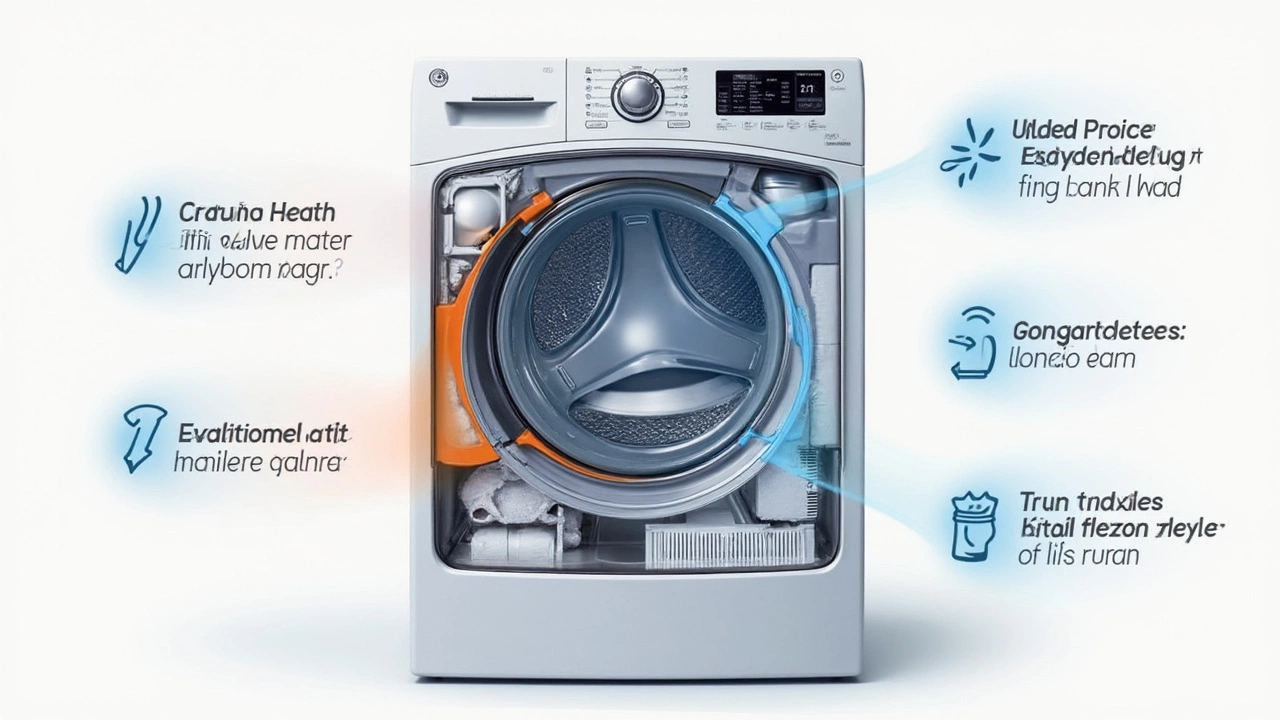Ever reach into the dryer, expecting warm, fluffy towels, and instead pull out a soggy pile? Yeah, that's one of the most annoying things that can happen on laundry day. Most dryer problems start small but get worse (and more expensive) unless you catch them early. A little know-how goes a long way.
One common hassle is a dryer that runs but doesn’t heat up. If your clothes are taking way longer than usual, there’s a good chance something’s off with the heating element or the thermostat. Another clue? A dryer that thumps, screeches, or rattles—usually this means a worn drum support or a loose belt, not just an old house creaking.
Don’t just blame a clogged lint trap either. Sometimes, air can’t get out properly because of a blocked vent or something stuck deeper in the machine. Ignoring stuff like this isn’t only bad for your clothes—it’s a legit fire risk. Regularly cleaning out the filter and checking the vent hose can save you cash and stress.
If you spot clothes coming out super hot and damp, or the dryer just shutting off after a few minutes, it could be overheating and shutting down for safety. That’s your cue to take a closer look instead of just restarting it. Thankfully, most problems have a simple cause—and a simple fix—if you know what to look for.
- Signs Your Dryer Is Acting Up
- The Most Common Problems and Their Causes
- Quick Fixes Most People Can Try
- When You Need a Pro (and When You Don't)
Signs Your Dryer Is Acting Up
If you think your dryer is acting weird, don't ignore it. You can save yourself time, money, and even prevent a fire by spotting trouble early. Here’s what to watch out for before things go south.
- Dryer repair issues often show up as longer drying times. If you need more than one cycle to get things dry, something’s not right.
- If your dryer feels way hotter than usual but clothes are still damp, it might be overheating and shutting off before the job’s done.
- Weird sounds, like banging or squeaking, aren’t just annoying—they usually mean a belt, roller, or bearing is wearing out.
- A burning smell coming from the machine is a big red flag. Lint buildup inside the dryer or vent can catch fire, so kill the power and check it right away.
- Wet clothes at the end of a normal cycle sometimes mean a broken heating element or blocked vent.
- If the dryer doesn’t even turn on, don’t panic. Door switches, fuses, or even power issues could be the culprit.
Here’s a quick look at what these signs often mean and how common they are:
| Problem | What It Might Mean | Estimated % of Cases* |
|---|---|---|
| Long Drying Times | Clogged vent, lint filter, weak heating element | 40% |
| Weird Noises | Bad rollers, worn belt, off-balance drum | 25% |
| Burning Smell | Lint buildup, overheating | 10% |
| No Heat | Broken element, faulty thermostat | 15% |
| No Power | Bad switch, blown fuse, power outlet issue | 10% |
*Rough figures based on repair shop stats from 2024.
Bottom line, catching these signs early can make life easier. Don’t wait for a full breakdown—check things out when you first spot a change.
The Most Common Problems and Their Causes
Most folks run into the same handful of headaches with their dryers, no matter the brand. Some issues are so common, repair pros see them every single week. The trick is knowing what causes what—and which ones you can tackle yourself.
Dryer repair usually boils down to a few regular culprits. Here are the biggest offenders:
- No Heat or Low Heat: This usually means a busted heating element, a tripped thermal fuse, or a bad thermostat. Electric dryers rely on a heating coil—if it’s shot, you’ll get nothing but cold tumbling. Gas dryers have igniters and gas valves, both of which can conk out.
- Long Drying Times: This problem has a top suspect: lint—a lot of it. Lint blocks airflow, so the dryer can’t move hot air efficiently. Sometimes it’s the vent hose, sometimes it’s the duct in your wall, but over 25% of dryer fires are caused by lint buildup, according to the U.S. Fire Administration.
- Weird Noises or Banging: Worn drum rollers, a frayed drive belt, or busted bearings are the main causes. That thumping isn’t normal. If you ignore it, you can end up with even worse damage.
- Drum Not Spinning: If you hear the motor running but nothing is moving, it’s probably a broken belt. If the dryer is totally silent, check the start switch or the door switch—they can wear out too.
- Dryer Shutting Off Too Soon: This points to a tripped thermostat, overheating, or blocked ventilation. The dryer’s just protecting itself, but you’ll need to find the blockage or swap the thermostat before normal service resumes.
Here’s a quick look at how these problems stack up in real-life repair calls:
| Problem | % of Service Calls | Main Cause |
|---|---|---|
| No Heat | 40% | Heating element, fuse, thermostat |
| Long Dry Time | 30% | Lint buildup, vent blockage |
| Noisy Operation | 15% | Drum rollers, belt, bearings |
| Drum Won't Spin | 10% | Belt, motor, door switch |
| Stops Too Soon | 5% | Overheating, thermostat, vent |
Some dryers have error codes that pop up on their screen. These can help you zero in on the exact part that’s acting up—saves tons of guesswork. If your dryer’s as basic as a flip phone, you’ll have to go old school and listen, sniff, and inspect.
Bottom line: if your dryer isn’t working like it should, it’s almost always one of these usual suspects. Spotting the cause early can save you money, hassle, and, in some cases, your laundry day sanity.

Quick Fixes Most People Can Try
If your dryer’s acting up, there are actually a bunch of quick things you can try before calling anyone for help. They don’t require fancy tools or any deep know-how—just a basic screwdriver and a little common sense.
Most dryer glitches start with airflow. If your dryer isn’t drying clothes like it used to, check the lint filter. Even a thin layer of fuzz can block air and slow everything down. Just slide the filter out and wipe it clean. Do this every load—a clogged filter isn’t just bad for performance, it’s a fire hazard. Next, take a look at the vent hose (the fat silver pipe heading out the back). If it’s crimped or full of lint, your dryer can’t breathe. Pull the machine forward, disconnect the hose (unplug your dryer first!), and shake or vacuum it out.
- Make sure nothing is blocking the outside vent flap. Animals love these spots, especially in winter.
- Spin the drum by hand. If it’s hard to turn or screeches, your belt might be loose or the drum rollers could be gunked up with lint. Sometimes just clearing out the mess can quiet things down.
- Try a reset—unplug the dryer for a few minutes and plug it back in. Sometimes a power cycle will clear minor issues with newer digital controls.
If your dryer won’t heat but still runs, check your home’s circuit breaker. Electric dryers need two breakers—one might have tripped, especially after a storm. Flip both off and then on again. Still nothing? Give the thermal fuse a look if you’re comfortable opening the back panel. It’s a cheap part and blows out to protect your dryer if it gets too hot. You can grab a replacement at any hardware store.
Lastly, weird smells coming from your machine could be a sign of a lint buildup or even a small, hidden sock cooking somewhere inside. A good deep clean and a flashlight check around the drum seal solve this nine times out of ten.
When You Need a Pro (and When You Don't)
Some dryer issues are easy enough for almost anyone to handle. For example, changing out a clogged lint filter or cleaning a vent hose just takes a few minutes, and you don't need any special tools. Swapping a busted door switch, or even replacing the drive belt, is usually doable with a screwdriver and about forty spare minutes. There are loads of how-to videos online if you get stuck.
But here’s the thing: dryers have serious electrical parts, and the heating element inside can pack a punch. If your dryer repair involves testing high-voltage wires, installing a new motor, or replacing the heating element itself, it’s smart to call someone who knows their way around. Not worth risking a shock or blowing up a fuse box just to save a few bucks.
- If you smell burning, see scorch marks, or notice the drum stops spinning but the timer keeps running, stop and call a professional.
- Diagnosing a faulty control board or sensor usually takes special gear and know-how.
- If you have a brand-new dryer under warranty, tinkering on your own could void that coverage. Let the service crew handle it.
Quick stats: according to a 2024 home appliance survey, over 60% of dryer repairs completed by DIYers involved just cleaning or replacing small parts—like lint traps or belts. But for bigger faults, 75% of successful fixes involved a pro coming out. That’s a pretty clear line.
| Repair Type | DIY Success Rate | Pro Recommended |
|---|---|---|
| Lint Trap/Vent Cleaning | 95% | No |
| Belt Replacement | 70% | Maybe |
| Heating Element | 20% | Yes |
| Control Board | 10% | Yes |
Bottom line: If you’re dealing with easy stuff—cleaning, checking for loose parts, or replacing an obvious bit—go for it. But if you hit anything electric, start seeing smoke, or don’t even know what you’re looking at, do yourself (and your house) a favor and ring up a professional.


